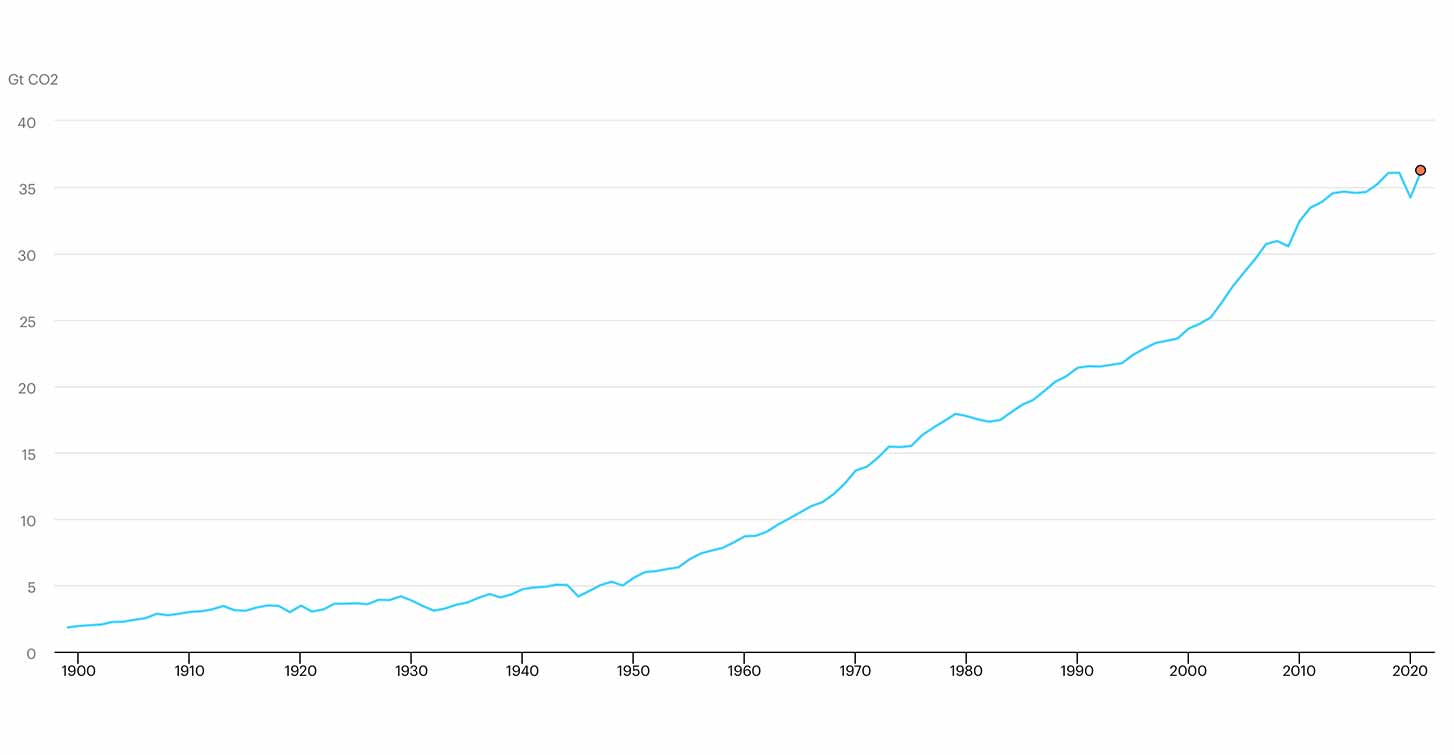Four tips to reduce the CO₂ emitted in the jeans production
Up to 8% of the total annual carbon emissions can be correlated to the fashion industry
Written by Felipe Guerreiro, Strategic Marketing Manager of Garmon Chemicals
Carbon emissions have been an increasingly hot topic in a world that is getting warmer every year. We don't have many choices: we must reduce carbon emissions as much as possible to minimize the environmental impacts that happen all over the world.

Figure 1: CO₂ emissions from energy combustion and industrial processes, 1900-2021
(IEA (2022), Global Energy Review: CO₂ Emissions in 2021, IEA, Paris)
According to the report Global Energy Review: CO₂ Emissions in 2021, published by the International Energy Agency (IEA), carbon emissions in 2021 had an increase of 6%, reaching the highest value in history: 36.3 billions of tons.
The increase is mainly due to the economic recovery post-pandemic and to the increase in coal burning, a consequence of fluctuations in the price of natural gas and other energy sources.
The fashion industry has a large share in these emissions. It is estimated that up to 8% of the total annual carbon emissions are correlated to the fashion industry and its annual production of more than 100 billion garments per year. Although much has been said, there is still much to be done to really minimize the carbon footprint of the fashion and apparel production chain.
Today, to produce fashion looks, we still use old-fashioned methods
Here are some tips that can help to reduce the carbon footprint in the production chain of a pair of jeans:
1. Coal-free jeans
Stop burning coal! Burning coal sounds an old technique, but it is still in practice in many countries around the world to produce heat. In 2021 coal burning reached the highest level of greenhouse gas emissions of 15.3 billion tons, more than 40% of total emissions!
Moving away from coal is essential to reduce carbon dioxide emissions. Alternative sources to coal include natural gas and biomass. Laundries should work hard to replace coal, and this measure needs to be valued by brands and communicated to end consumers.
2. Jeans with renewable sources
Shift to renewable electricity: solar and wind power are alternatives to reduce the use of coal, fossil fuels and non-renewable energy. The implementation of solar panels is perhaps the best-known solution and the most economically viable at the moment, as the prices for this implementation have been reducing year after year. Large laundries in the world already use this technology and contribute to lower carbon dioxide emissions.
3. Pumice-free jeans
Don’t use pumice stones! The use of stones is another old-fashioned process still present in jeans washes. Besides the environmental impacts of extracting and discharging the stones, the stones require extensive transportation, increasing the emission of greenhouse gases as trucks burn fossil fuels. Avoid using stones.
Today, the utilization of enzymes can achieve equivalent results, as it is the case of the kemzymes line. To learn more about how to eliminate pumice stones from the jeans manufacturing process, read our article on this topic!
4. Jeans with sustainable processes
Implement processes that reduce CO₂ emissions: several new processes can help you work at lower temperatures, reducing the use of heat and combustible fuels. One of example is the smart foam technology, launched by Garmon in 2019.
This technology goes beyond saving water and can help reduce the emission of greenhouse gases, since all processes are performed at room temperature, meaning no hot water, drastically reducing emissions.
To sum up
The apparel production has increased and continues to excessively use natural resources, contributing to the rise of carbon emissions. Our challenge to reduce CO₂ is huge and we need to work together across the whole chain to accomplish the goal, connecting brands, laundries and consumers to move in the right direction.
As part of the solution, everyone has the responsibility of playing an active role, either by choosing good suppliers who are committed to this cause, either by working directly on the optimization and implementation of processes that reduce carbon emissions, or by purchasing more responsibly from those who strive to produce more sustainable jeans.
To learn more about Garmon's CO₂ actions in the chemical supply chain, contact us.
Contact usReferences:
IEA (2022), Global Energy Review: CO2 Emissions in 2021, IEA, Paris https://www.iea.org/reports/global-energy-review-co2-emissions-in-2021-2, License: CC BY 4.0
AII & FFG (2022), UNLOCKING THE TRILLION-DOLLAR FASHION DECARBONISATION OPPORTUNITY: Existing and innovative solutions, Apparel Impact Institute (AII) and Fashion for Good (FFG). UNLOCKING THE TRILLION-DOLLAR FASHION DECARBONISATION OPPORTUNITY REPORT - Apparel Impact Institute